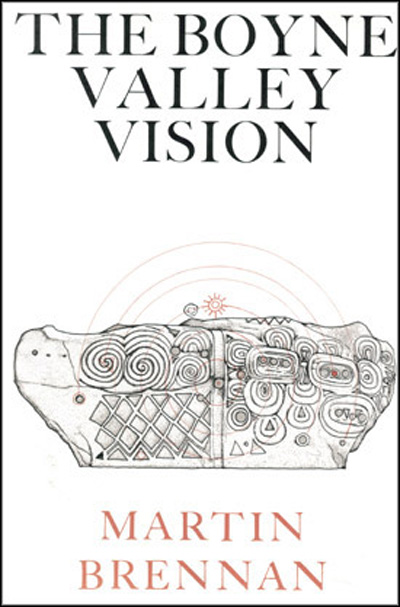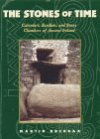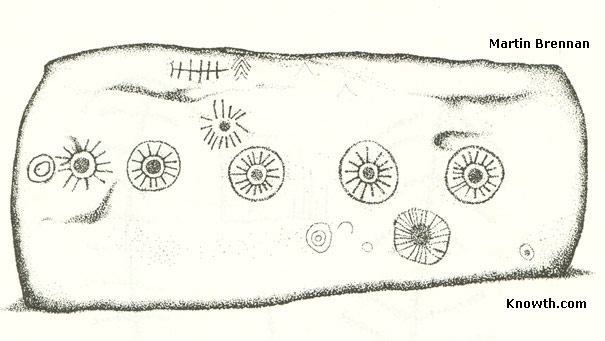The Boyne Valley Vision
 The Boyne Valley Vision
by Martin Brennan. Published by The Dolmen Press in 1980.
The Boyne Valley Vision
by Martin Brennan. Published by The Dolmen Press in 1980.
In this book Martin Brennan presents an entirely new interpretation of these monuments, one which challenges the conclusions of earlier studies and offers conclusive evidence which radically changes our knowledge of megalithic culture in Ireland. The Boyne Valley Vision is a personal step-by-step account of a quest that has resulted in some of the most astounding and profound archaeological decipherments of our time.
Martin Brennan demonstrates in his text and in some ninety drawings and figures from his pen the vision of the universe transmitted by the artists of megalithic Ireland in their designs carved in naked rock. He shows that the ideas expressed by these artists are more substantial than the stones on which they are incised. His study exposes for the first time an entire cosmology, a vocabulary of symbols, the sundials, the calendar and other scientific tools of the oldest culture known to us.
Purchase at Amazon.com or Amazon.co.uk
Although The Boyne Valley Vision is not strictly an archaeological work, it proposes some of the most far-reaching archaeological discoveries of our time. As a study of the earliest manifestations of art in Ireland, Martin Brennan's book provides new insights into these enigmatic designs and points the way to an understanding which was never possible before, an understanding of a message that justifies the wonder with which past ages have regarded them. Our view of Ireland's past can never remain the same.
The Boyne Valley Vision - Contents
- The Boyne Valley Vision
- Silent Stones
- The Light Beam Symbol
- The Vision of the Triple Spiral
- On the Plains of Royal Meath
- Burning Water
- Confronting the Demon
- The Secret of the Stones
- Stones of Cycles
- The Master Diallers of the New Stone Age
- Cycles of Spheres
- The Vision over the Sacred Isle
Text from 1st Chapter:
The ancient mounds in the Boyne Valley are a great feat of non-verbal communication. Their message comes to us through four millennia of time. By using universal and concrete symbols like the sun and the earth itself, this message transcends the barriers of language. These mounds are concrete realizations of the world view of ancient man in Ireland. In this great vision, the whole cosmos is symbolized. The more closely we examine it, the more we realize that nothing about the mounds is arbitrary; everything is precisely calculated to fulfil a definite purpose. They are constructed to reveal truths rather than to hide mysteries. It is remarkable that they have remained a mystery for so long.The reason they have remained a mystery is that we have approached them with rigidly applied preconceptions. For some time we have known that the sun's rays illuminate (the chamber of Newgrange on winter solstice sunrise, but we have been too short-sighted to realize that this is only the beginning of a system that takes in a whole network of mounds in the Boyne Valley. We have underestimated the capacities of prehistoric man. Behind the story of how the secrets of the Boyne Valley were revealed there is an equally fascinating story of how they have remained hidden for so long.
High on the list of preconceptions is the cult of progress. The myth of progress implies that progress is made only in a straight line extending from the past to the future. The future is ever brighter and more civilized while the past is dark and barbarous. Progress is not such a simple matter. It is possible that some cultures may have developed a sophisticated science and technology and then have died out or given way to more barbaric cultures. Such a disappearance could be an evolutionary accident.
Another stumbling block has been the tendency to jump to conclusions about burial finds in these mounds, which have become 'passage-graves' and are described as 'tombs'. This explanation is felt to be adequate and further understanding of them stops there. We will see clearly that burial plays a minor role in the conception of these mounds which have a multiplicity of purposes. If I had thought that I was dealing with a huge cemetery at the beginning of my research, I would have treated the builders as a strange society with a fixation on a cult of the dead. The 'Boyne Valley Vision' will dispel this idea finally and conclusively and place the mounds in a more realistic perspective.
It is time for a reappraisal of our interpretations of megalithic sites. In order to realize fully the achievements of this highly creative and resourceful culture, we must take a new look at what lies before our eyes. Before us is an important part of our spiritual heritage which has been lost. This book attempts, among other things, to recover this spiritual well-spring and give it the recognition it deserves.
Research in other countries and in the literatures of other cultures played an important part in my discoveries. During a trip to Mexico, for instance, I learned a great deal about ancient Mayan astronomy which was ultimately helpful in my work at Newgrange. Sites like Teotihuacan in Mexico provided a good deal of speculative material about mound builders. All the monuments there are oriented in relation to the sun. This is in perfect accord with Nahuatl cosmology. Ignacio Marquina, the Mexican architect, discovered that the major pyramid aligns exactly with the setting sun on summer solstice. In the Boyne Valley, sunset on summer solstice is also marked by a dramatic alignment which is illustrated in this book.
In exploring the mounds in the Boyne Valley, I found an expression of oneness with nature that we seem to have lost in our age. We will only fully grasp the meaning of the ancient sites when we realize the meaning of our own lives more fully and the meaning of the other living forces around us. To understand the works of enlightened people we must be 'enlightened ourselves. Those who see the vision of unity expressed in the stones will see not only a reality that has sustained man on this island for thousands of years but will also see a vision of the future - a way of reconciliation with the totality of nature and our place in it.
Since they were first uncovered in 1699, the ancient stones in the Boyne Valley have been the subject of continual controversy. Many attempts have been made to understand the purpose of the Boyne Valley mounds and the meaning of the carved designs on the stones in and around the mounds. Scholars, scientists and antiquarians who have attempted to interpret the designs on the stones can be roughly divided into three groups. In the first group - by far the largest - are those who do not claim to know what the designs mean but who believe they must have symbolic significance. This is the overwhelming verdict of twentieth century scholarship. In the second group are those who believe the designs are merely ornamental. The last group includes those who believe the designs must constitute some sort of writing.
Many distinguished twentieth century scholars hold the first theory. R.A.S. Macalister, for instance, stated that it would be futile to attach a specific meaning to the stone engravings because no literary or traditional recollection of religious ideas survives from the time when the stones were first carved and set in place. Seán P Ó Ríordáin shares this view. He states, 'They are religious symbols which had sacred meaning for the tomb builders. What that meaning was we have no means of knowing Antiquities of the Irish Countryside, 1942.
In a more recent study, Michael Herity says with similar caution, 'For the most part, the symbols or elements Presented in this scheme allow of so wide a range of interpretation that it is prudent not to attempt a speculative elucidation' Irish Passage Graves, 1974. In the same year Evan Hadingham published his Ancient Carvings in Britain: A Mystery. The title of his book is, in my opinion, a summary of his conclusions. Cautious modem scholarship has undoubtedly added valuable information to the little we know about the Boyne Valley stones. Yet its general trend has been discouraging. In many ways we have come no nearer to understanding the stones than William Wakeman, who, more than a century ago, thought the stone designs were 'bizarre, cryptic, sepulchral scorings' and who concluded 'the mystery in which they are at present enveloped may never be dispelled' (Handbook of Irish Antiquities, 1848).
The most optimistic modem archaeologist is Claire O'Kelly. In her opinion, the stones were obviously carved to fulfil a 'ceremonial or spiritual or symbolic purpose' (Passage-grave Art in the Boyne Valley, 1978). O'Kelly counted the devices and placed them in ten categories. Some of the devices, however, she could only label 'doodles'. She discusses also the claim for an anthropomorphic element in the engravings (the eyes, ears, noses and other parts of the body seen by imaginative investigators) and concludes that such interpretations are 'of necessity so subjective as to be almost valueless (Passage-grave Art). She comes closer to understanding the true nature of the designs than other archaeologists when she states, 'To all appearances, all the motifs are geometrical and non-representational' (Passage-grave Art). And she is hopeful that, 'When a fuller corpus of ornament is available than at present, it may be possible to discern some pattern or purpose in what now appear mostly as random, or indeed often purposeless markings' (Passage-grave Art).
Modem research has, for the most part, taken a negative approach to the problem of the carved stones; the tendency has been to explain what the stones are not. This approach, however, is still more fruitful than the theory of the second group who believed the designs to be rude scribblings or mere ornament. The Welsh antiquary, Edward Lhwyd (1660-1708), who claimed to be the discoverer of Newgrange in 1694, saw in the spirals a snake 'without distinction of head or tail' (Letter to Dr. Tancred Robinson dated December 15, 1699 in Transactions of the Royal Society). He described the entrance stone as a rude carving and decided that the mound was simply a 'barbarous monument'. Thomas Molyneux, Professor of Physic at Trinity College, also thought the designs were 'a barbarous kind of carving' without 'the least footsteps of writing' ('A Discourse concerning the Danish Mounds, Forts and Towers' in A Natural History of Ireland III, 1726).
James Ferguson, a late nineteenth century investigator was more equivocal. On the one hand, he believed the carvings at Newgrange were ornamental and he saw in them 'free-traced vegetable forms' (Rude Stone Monuments in all countries, 1872). On the other hand, he said that the designs 'may really be intended to suggest an idea. . . but of what nature we ' are not yet in a position to guess' (Rude Stone Monuments). He has no doubt, however, about the carvings at Loughcrew and states flatly, 'In no one instance does it seem possible to guess what these figures were meant to represent' (Rude Stone Monuments). He concludes that the stone-cutters must have aimed at sheer beauty of form.
Martin Brennan was born of Irish parents in Brooklyn, New York. He was a student of Pratt Institute,
where he majored in Visual Communication. He worked briefly in graphic design before going to Mexico
where his interests in prehistoric rock inscriptions, ritual and traditional art developed. He moved
to Japan for some years and there the scholar Kimitaro Kitamura urged him to go to Ireland and study
ancient Irish culture. He has lived in Ireland for the past ten years, working in graphic design and
pursuing his study of megalithic art. He has returned to America to lecture on ancient Irish Art.
His research for The Boyne Valley Vision has been in part supported by the East-West Foundation.
Sleeve Notes: The Boyne Valley Vision 1980.
 The Stones of Time - Calendars, Sundials and Stone Chambers of Ancient Ireland by Martin
Brennan, first published in 1983 as The Stars and the Stones.
The stone complexes of ancient Ireland have been extensively excavated and studied, yet they have refused to give up their mystery. Archaeologists have
speculated that the chambers were tombs. Art historians have tried to interpret the enigmatic designs painstakingly carved into the faces of the stones. But the
real function of these ancient structures can be understood only when the art and architecture are seen to be parts of a unified whole.
The Stones of Time - Calendars, Sundials and Stone Chambers of Ancient Ireland by Martin
Brennan, first published in 1983 as The Stars and the Stones.
The stone complexes of ancient Ireland have been extensively excavated and studied, yet they have refused to give up their mystery. Archaeologists have
speculated that the chambers were tombs. Art historians have tried to interpret the enigmatic designs painstakingly carved into the faces of the stones. But the
real function of these ancient structures can be understood only when the art and architecture are seen to be parts of a unified whole.
Boyne Valley Private Day Tour
 Immerse yourself in the rich heritage and culture of the Boyne Valley with our full-day private tours.
Visit Newgrange World Heritage site, explore the Hill of Slane, where Saint Patrick famously lit the Paschal fire.
Discover the Hill of Tara, the ancient seat of power for the High Kings of Ireland.
Book Now
Immerse yourself in the rich heritage and culture of the Boyne Valley with our full-day private tours.
Visit Newgrange World Heritage site, explore the Hill of Slane, where Saint Patrick famously lit the Paschal fire.
Discover the Hill of Tara, the ancient seat of power for the High Kings of Ireland.
Book Now

